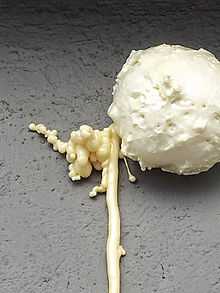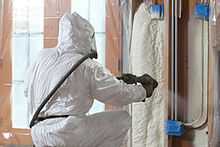Spray foams (insulation)
Spray foam insulation is an alternative to traditional building insulation such as fiberglass. A two-component mixture composed of isocyanate and polyol resin comes together at the tip of a gun, and forms an expanding foam that is sprayed onto roof tiles, concrete slabs, into wall cavities, or through holes drilled in into a cavity of a finished wall.

History
Polyurethane, the most common type of spray foam insulation, was developed and used by the military in the 1940s and applied to airplanes. It wasn't until the 1970s that it started to be used as foam insulation.
Various systems are used to apply the spray foam. The two component high pressure system is generally used in new home construction. It is a quick expanding type of spray foam. The two component low pressure spray foam is another system that is used primarily for remodel jobs where there are existing walls with drywall already in place. This is also known as a slow rise formula and often referred to as injection foam.
Types
Spray foam insulation can be categorized into two different types: open cell and closed cell.

Open cell foam insulation
Open cell is a type of foam where the tiny cells are not completely closed. Open cell is less expensive because it uses fewer chemicals. It is a very good air barrier but does not provide any type of water vapor barrier. It is much more sponge-like in appearance. It is often used for interior walls because it provides sound reduction. It is not recommended for outdoor applications.
Closed cell foam insulation
Closed cell foam insulation is much denser than open cell. It has a smaller, more compact cell structure. It is a very good air barrier as well as a water vapor barrier. It is often used in roofing projects or other outdoor applications, but can be used anywhere in the home.
Benefits
Spray foam insulation saves on energy costs and lowers utility bills. Studies by the US Department of Energy show that 40% of a home's energy is lost as the result of air infiltration through walls, windows and doorways.[1] Buildings treated with spray foam insulation typically insulate as much as 50% better than traditional insulation products.[2]
Insulation that is sprayed in buildings protects against moisture, which provides the benefit of reducing the chance of harmful mold and mildew.[1][3] Eliminating mold growth reduces the likelihood of rotting wood in a home, and allergic reactions to mold spores.[3]
In addition to building temperature and moisture control, spray foam insulation is often used to reduce noise.[1][3] Foam insulation serves as a barrier to airborne sounds, and reduces airborne sound transfer through a building's roof, floor and walls.[2]
In the United States, homes treated with spray foam insulation often qualify for state and federal tax deductions.[3][4]
Thermal resistance
R-value is the term given to thermal resistance to heat flow. The higher the R-value of an insulation product, the more effective the insulation properties.[5] 1.8-2 pound polyurethane foam has the highest R-value of readily available insulation used in homes and buildings.[5][6]
Polyurethane is a closed-cell foam insulation material that contains a low-conductivity gas in its cells.[7] As a result of the high thermal resistance of the gas, spray polyurethane insulation typically has an R-value around R-5 to R-6 per inch.[7] In comparison, blown fiberglass typically has an R-Value of only R-2 to R-4 per inch.[8]
Foam insulation blocks all three forms of heat transfer:
- Conductive heat transfer
- The flow of thermal energy through a substance from a higher to a lower temperature region. Foam thermoset plastics block conductive heat transfer due in part to having very loose molecular bonds; In addition the cells of the installed spray foam are either filled with air in the case of open cell foam or 245fa in closed cell foam.
- Radiant heat transfer
- The process by which heat energy in the form of light (usually IR unless the substrate is hot enough to glow in the visible range) is emitted more strongly by warm surfaces and absorbed by other materials especially those of low IR reflectivity (think matte black finish). Radiant heat transfer does not require a medium. Thermoset foams, such as spray foam insulation, have the ability to reflect radiant heat. This is due to the reflective (shiny, in terms of IR) surfaces within the cell structure of the foam.
- Convective heat transfer
- Heat which is created elsewhere that is transported by means of a fluid, such as water or in our case air.Spray foam insulation's most important attribute is the ability to air seal creating a custom airtight envelope within the building structure. The added benefit to air sealing is the ability to block convective heat transfer from interior to exterior during heating months and vice versa during cooling months, as the heat cannot escape through gaps in the buildings envelope without the aid of air movement from infiltration as a means of transport.[9]
Disadvantages
Health effects
Isocyanates are powerful irritants to the eyes and gastrointestinal as well as the respiratory tracts. Direct skin contact with isocyanates can also cause marked inflammation. Some people say that their eyes feel like they have sand in them at the onset of problems. Some break out in a rash on their arms, chest, and neck.
Overexposure to isocyanates can sensitize workers, making them subject to asthma attacks if they are exposed again. Respiratory irritation may progress to a chemical bronchitis. Additional exposures can make the onset easier with less isocyanate necessary to start the attack.
Sporadic cases of hypersensitivity pneumonitis (HP) have also been reported in workers exposed to isocyanates. The symptoms may seem like the flu, with fever, muscle aches, and headaches. Other symptoms may include a dry cough, chest tightness, and difficult breathing. Individuals with chronic HP often experience progressively more difficult breathing, fatigue, and weight loss. Individuals with acute HP typically develop symptoms 4-6 hours after exposure.[10][6]
Spray foam insulation is typically non-toxic only after it has cured. While curing spray foam emits a gas that causes blurred vision and trouble breathing. Using full face and respiratory protection while applying the product is recommended. After being sprayed, it expands to roughly 30-100 times its original volume. As a result, it is able to fill vacant air gaps, and will expand and contract in relation to the building.[11]
Damage to roofs
Asphalt roof manufacturers recommend against using spray foam directly on the under-side of roof sheathing called a hot roof. The lack of ventilation allows high heat buildup which is the primary cause of deterioration in asphalt shingles.[12]
Environmental properties
Insulation of all types stop a good deal of energy loss. Some types including spray foams also seal air leaks. Insulation can also save energy in hot climates by reducing air conditioning use.
Spray foam insulation levels vary, with some providing up to an R-value of 6.7 per inch.
References
- ↑ 1.0 1.1 1.2 Spray Foam Insulation Guide for Homeowners
- ↑ 2.0 2.1 How Spray Foam Insulation Provides a More Energy Efficient Home
- ↑ 3.0 3.1 3.2 3.3 Benefits of Spray Foam Insulation
- ↑ Federal Tax Credits for Consumer Energy Efficiency
- ↑ 5.0 5.1 Why is Polyurethane Foam so effective?
- ↑ 6.0 6.1 Insulation Alternatives: Sprayed Foam Insulation
- ↑ 7.0 7.1 Polyurethane Insulation Materials
- ↑ Insulation Values For Selected Materials
- ↑ Spray Foam FAQs
- ↑ Foam Insulation vs Standard Insulations
- ↑ Spray Foam Insulation: Installation, Tips and Best Practices
- ↑ http://www.casma.ca/en/bulletin_33.shtml